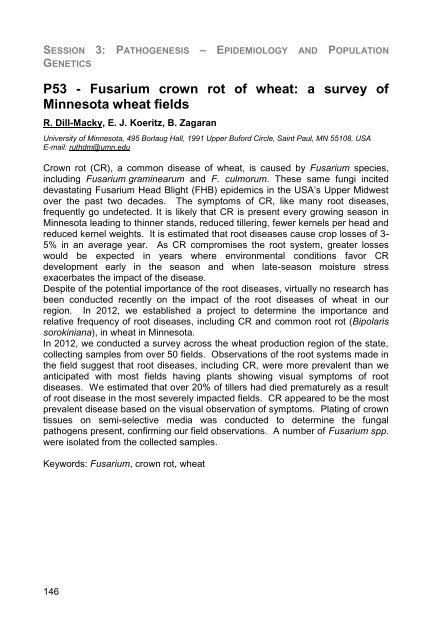EFS12- Book of abstracts - Contact
EFS12- Book of abstracts - Contact
EFS12- Book of abstracts - Contact
You also want an ePaper? Increase the reach of your titles
YUMPU automatically turns print PDFs into web optimized ePapers that Google loves.
SESSION 3: PATHOGENESIS – EPIDEMIOLOGY AND POPULATION<br />
GENETICS<br />
P53 - Fusarium crown rot <strong>of</strong> wheat: a survey <strong>of</strong><br />
Minnesota wheat fields<br />
R. Dill-Macky, E. J. Koeritz, B. Zagaran<br />
University <strong>of</strong> Minnesota, 495 Borlaug Hall, 1991 Upper Buford Circle, Saint Paul, MN 55108, USA<br />
E-mail: ruthdm@umn.edu<br />
Crown rot (CR), a common disease <strong>of</strong> wheat, is caused by Fusarium species,<br />
including Fusarium graminearum and F. culmorum. These same fungi incited<br />
devastating Fusarium Head Blight (FHB) epidemics in the USA’s Upper Midwest<br />
over the past two decades. The symptoms <strong>of</strong> CR, like many root diseases,<br />
frequently go undetected. It is likely that CR is present every growing season in<br />
Minnesota leading to thinner stands, reduced tillering, fewer kernels per head and<br />
reduced kernel weights. It is estimated that root diseases cause crop losses <strong>of</strong> 3-<br />
5% in an average year. As CR compromises the root system, greater losses<br />
would be expected in years where environmental conditions favor CR<br />
development early in the season and when late-season moisture stress<br />
exacerbates the impact <strong>of</strong> the disease.<br />
Despite <strong>of</strong> the potential importance <strong>of</strong> the root diseases, virtually no research has<br />
been conducted recently on the impact <strong>of</strong> the root diseases <strong>of</strong> wheat in our<br />
region. In 2012, we established a project to determine the importance and<br />
relative frequency <strong>of</strong> root diseases, including CR and common root rot (Bipolaris<br />
sorokiniana), in wheat in Minnesota.<br />
In 2012, we conducted a survey across the wheat production region <strong>of</strong> the state,<br />
collecting samples from over 50 fields. Observations <strong>of</strong> the root systems made in<br />
the field suggest that root diseases, including CR, were more prevalent than we<br />
anticipated with most fields having plants showing visual symptoms <strong>of</strong> root<br />
diseases. We estimated that over 20% <strong>of</strong> tillers had died prematurely as a result<br />
<strong>of</strong> root disease in the most severely impacted fields. CR appeared to be the most<br />
prevalent disease based on the visual observation <strong>of</strong> symptoms. Plating <strong>of</strong> crown<br />
tissues on semi-selective media was conducted to determine the fungal<br />
pathogens present, confirming our field observations. A number <strong>of</strong> Fusarium spp.<br />
were isolated from the collected samples.<br />
Keywords: Fusarium, crown rot, wheat<br />
146
















![Présentation CRB-anim [Mode de compatibilité] - Inra](https://img.yumpu.com/17418636/1/190x135/presentation-crb-anim-mode-de-compatibilite-inra.jpg?quality=85)